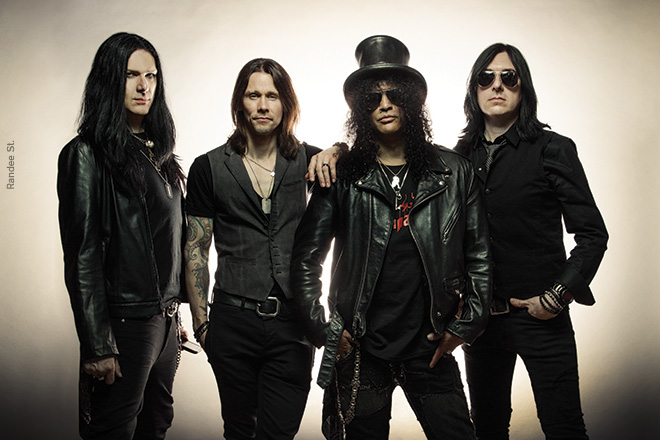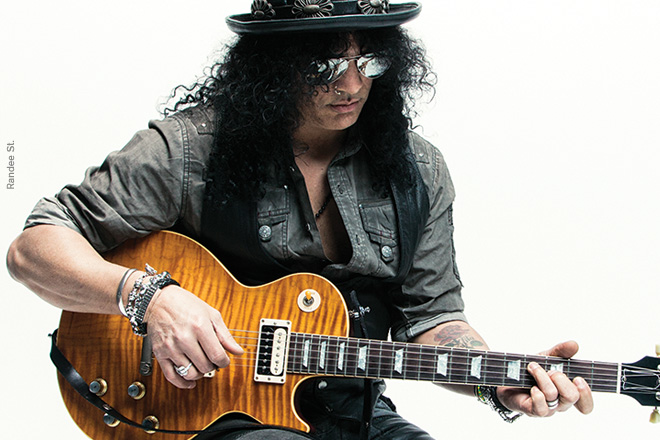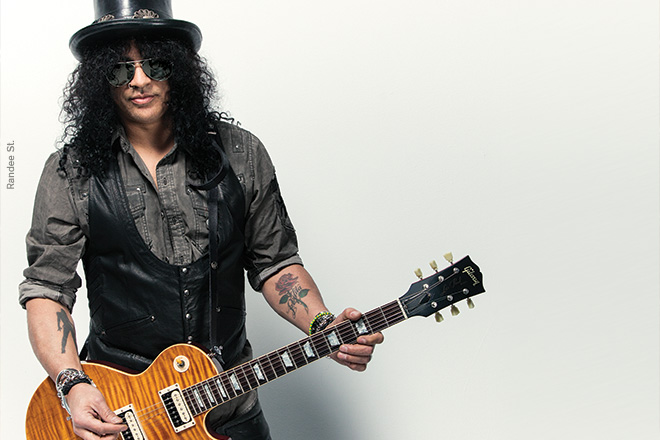World of His Own
Eighteen years after Guns N’ Roses, Slash releases an explosive new record that finds him at the peak of his creative prowess
I’m an energetic and aggressive player,” declares Slash. “I attack hard—it’s very much a physical thing for me. What excites me most is the off-the-cuff, spontaneous energy you get from live performance. That has a huge impact on me.”
That impact began at a young age when the future musician—born Saul Hudson—spent his preschool years in London with his father, an artist who helped design album covers for the likes of Neil Young and Joni Mitchell. At age 5 he journeyed to L.A. to reunite with his mother, a costume designer in the entertainment industry. Music was a constant presence at both locales. “In England, I remember my uncle and my dad playing the Moody Blues, the Stones, the Kinks and the Beatles,” Slash recalls. “Then, when I moved to the States, it was Bill Withers, the O’Jays, Led Zeppelin, War and Stevie Wonder on my mom’s side. It was all mixed together—a really musical and creative environment to grow up in.”
By 1981 Slash had formed his first band, enlisting childhood friend Steven Adler on drums and Duff McKagan on bass. The group sputtered, but fortunes changed after Slash met guitarist Izzy Stradlin and singer Axl Rose. Christening themselves Guns N’ Roses, the five bonded and honed their chops in L.A. clubs—garnering a reputation for spectacular shows and equally spectacular excess. But their compatibility as songwriters yielded a trove of rock classics. “Chemistry was a natural thing,” Slash recalls. “When we got past the distractions and just played, there was a synergy.”
Proof of that synergy was captured on the band’s debut album Appetite for Destruction in 1987. Powered by a cache of riff-driven rockers—“Welcome to the Jungle,” “Sweet Child O’ Mine” and “Paradise City,” to name a few—the record blew up. Sales topped 18 million, making it the best-selling debut record of all time in the U.S. The album also established Slash as one of rock’s most incendiary guitarists. “I’m a riff guy,” he says. “Even as a kid, way before I started playing guitar, I always gravitated to songs that had a cool guitar or piano riff, some sort of instrumental melody.” And his slightly dangerous image—the ubiquitous top hat, dark shades and corkscrew locks, along with a low-slung Les Paul—only further shrouded him in mystery.
Despite a run of acclaimed albums, internal strife and personnel changes dogged Guns N’ Roses, and in 1996 following a three-year hiatus Slash quit. By then his side project, Slash’s Snakepit, effectively launched his solo career. Velvet Revolver, the supergroup he formed in 2002, released two successful albums before going on hiatus six years later. In 2010, Slash recruited a bevy of talent including Ozzy Osbourne, Adam Levine, Dave Grohl, Chris Cornell, Iggy Pop, Fergie and Alter Bridge’s Myles Kennedy for his debut self-titled solo album. He tapped Kennedy again two years later for his Apocalyptic Love album, along with Slash’s touring band, the Conspirators—bassist Todd Kerns and drummer Brent Fitz.
Slash’s latest, World on Fire, showcases the explosive chemistry that began to evolve among Slash, Kennedy and the Conspirators. Most of the music was composed on the road, with Slash fleshing out ideas in hotel rooms and during soundchecks. “It was almost like it wrote itself,” he says. “That happens very rarely, where there’s a certain energy that carries the creative process. It’s almost like you’re not in control of it, where you just ride the wave.”
After several weeks of rehearsals in L.A., Slash brought in producer Mike “Elvis” Baskette to capture the right sound. “He came in with a great attitude,” says Slash. “He also brought a work ethic that was refreshing. Not only did he work his ass off to get the optimal performance from a sonic perspective, he also pushed everyone to perform at their peak.”
Spiced with the occasional ballad, World on Fire is nonetheless focused firmly on what Slash does best—delivering searing, guitar-drenched rock. In his near three-decade career, that consistency has never wavered. “I’m really passionate about what I do,” he says, “and I’m fortunate that other people seem to dig it, too. Probably the only reason I’ve managed to excel at this is because music and the guitar have always been 150 percent of my being.” From L.A., Slash spoke with us about the new album, elements of a great riff, and what drew him to the guitar in the first place.

How’d you approach the new album?
Actually I approached this record the way I’ve typically made albums. Apocalyptic Love was the exception, in that I wanted to record the guitars live with the bass and drums—just get a live, raw performance. With World on Fire, we went into the studio and got a live feel for the basic tracks, recording everything together, then I went back and dialed in the guitars, doing them in the control room. I played with the band just to capture the vibe.
You spend lots of time in preproduction.
That’s a technique I’ve never seen any reason to deviate from. You get the arrangement and rehearse it until you can play it comfortably. That doesn’t mean you know it like the back of your hand, it just means you can play the song confidently. Doing that allows you to get as spontaneous a take as possible. You can do that inside five takes—maybe play a couple to warm up, and in the next three takes you’ve got a keeper.
Do you always record to tape?
If I can. It just sounds better—warmer, more natural and more organic than digital. I love it for drums as well. The only time I got away from using tape was when I did the two Velvet Revolver records. That was because everyone was using Pro Tools, and I never questioned it. But I had an eye-opening experience recording the first Velvet Revolver record. I left the studio one night and later realized I had forgotten something, so I went back. The engineer was sitting there with Pro Tools scooting everything around. I was like, “What are you doing?” and he says, “Making it perfect.” I’m like, “That’s not what the band sounds like.”
Enjoy developing multiple guitar parts?
I enjoyed it on this album. It’s funny, I never set out to be in a two-guitar-player band—prior to Guns N’ Roses it was always just me. Then when I started playing with Izzy in GNR, I did my thing and he did his—and the result was some sort of magic chemistry that gave us that unique sound. But that was a one-in-a-million pairing. Since then I’ve mostly done all the guitars, then had somebody play live with me to fill things out. Apocalyptic Love was an exception, in that Myles played an Izzy kind of role. But for this album Myles wanted to concentrate on vocals—he didn’t want to play guitar. That opened the door for me to do more of the things I’d been hearing in my head. It was fun fleshing out those guitar parts in the studio.
How do you craft solos?
As we’re rehearsing I just go for what I’m hearing in my head. It’s a lot like coming up with a vocal, in the sense that the melody comes spontaneously. Because we do a lot of preproduction before we go into the studio, I have time to get familiar with the solo section. When it comes time to actually record the guitars, we already have a basic intro, middle section and outro. Within that framework I do a bunch of different takes, changing notes here and there, and see which ends up being the one I like. It’s never been complicated in terms of actually sitting down and writing it out and formulating it.
Do you still practice?
The way I keep my chops up—especially on the road—is just by playing every night. That’s the best form of practice—flying by the seat of your pants and going for it every night, coming up with ideas within the confines of the arrangement. That’s why if I’m not on the road or making a record, I’m jamming with other people or doing sessions. I find that if I practice in the conventional sense, I never apply what I’m doing to a live situation. It might seem cool when you’re sitting around messing with a run or a scale or a flurry of notes, but it never comes out that way in a live situation. Practice for the sake of practice makes sense only when I’m warming up for a gig.
What first drew you to the guitar?
I was listening to rock ’n’ roll guitar from the time I came from the womb. That’s all my dad and his brothers listened to when we were in England. I’ve always had an affinity for that magic break in a song where the electric guitar comes in. It was always about expression, about the guitar being part of the song. I thought of it as the other lead part, beside the vocal, where a certain statement was being made.

How’d you resist the ’80s shredder phenomenon?
I just stuck to what I had always dug about lead playing, which was never about technique as a goal unto itself. It was about the individuality of these guys I had been listening to—the fact that each had his own personality. Actually Eddie Van Halen was one of those guys. Eddie introduced some technique, but he also had great phrasing and a great sense of melody. No matter how fast he played it was still a statement within the song, still part of the song. As the ’80s unfolded, a lot of people just picked up on the technique aspect of what he was doing, and lost the soul. I never jumped on that bandwagon where you’re trying to outflash the next guy.
Has the era of great riffs passed?
Riffs have always been one of the things I love most about rock ’n’ roll. As a kid I was always attuned to riffs, even in songs I might not necessarily be into. In the ’80s, commercial music started getting away from guitars. Guitars were there only to add aggressiveness—the rest of the music was about keyboards and drum samples. Trends come and go. Today, unless you’re in a band that has influences that go back a ways, it’s all gone away from riffs. What’s popular now doesn’t relate much to what was popular when I was coming up. There have been lots of changes in music through the years, and I’ve just stuck to what I’ve been doing since I started.
What makes the Les Paul right for you?
The first electric guitar I got my hands on was a Les Paul. It was a copy—a sunburst Memphis Les Paul copy. Looking back, a lot of guitarists I liked played Les Pauls. You go with the sound you like and the look you like. I did go through a trial-and-error period where I tried out lots of guitars—Strats included—but within a couple of years I was right back to the Les Paul. I like a lot of Strat and Tele stuff as well, but I would rather make a Les Paul do the things those guitars do.
Why is your sound instantly recognizable?
That’s probably the greatest compliment I can get. I had never thought about it, but in recent years people have told me I have a definite sound, that they can tell who it is when I’m playing. I’m really floored by that. I think that’s the one thing all the guitar players I grew up listening to possessed—Joe Walsh, Pete Townshend, Angus Young, Mick Taylor and Keith Richards. They have their own way of attacking or fingering what they’re going for in terms of phrasing, that has nothing to do with the guitar or amp they’re using. If I’m in that category—if I’ve managed to pick up on a way of going about it that has its own character—then I’m blessed. M
By Russell Hall




comment closed